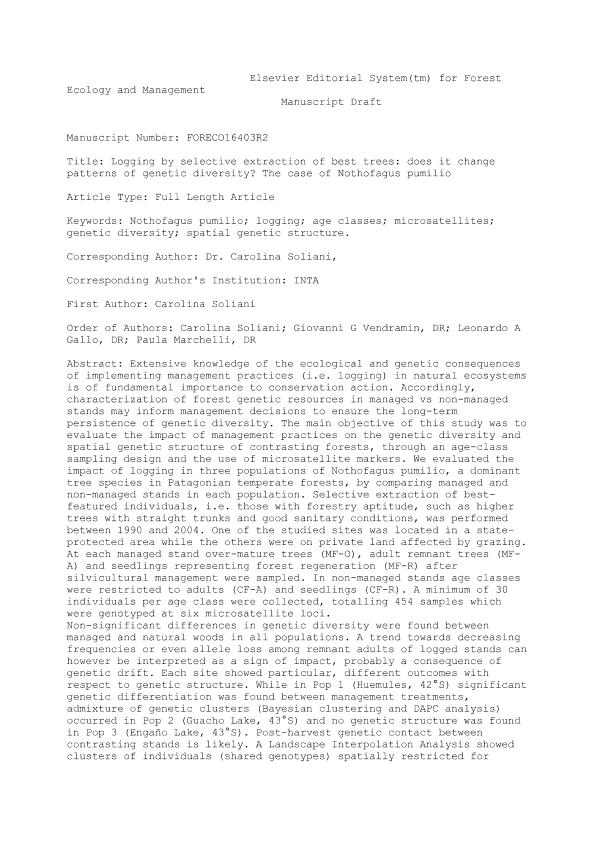Artículo
Logging by selective extraction of best trees: Does it change patterns of genetic diversity? The case of Nothofagus pumilio
Fecha de publicación:
08/2016
Editorial:
Elsevier Science
Revista:
Forest Ecology and Management
ISSN:
0378-1127
Idioma:
Inglés
Tipo de recurso:
Artículo publicado
Clasificación temática:
Resumen
Extensive knowledge of the ecological and genetic consequences of implementing management practices (i.e. logging) in natural ecosystems is of fundamental importance to conservation action. Accordingly, characterization of forest genetic resources in managed vs non-managed stands may inform management decisions to ensure the long-term persistence of genetic diversity. The main objective of this study was to evaluate the impact of management practices on the genetic diversity and spatial genetic structure of contrasting forests, through an age-class sampling design and the use of microsatellite markers. We evaluated the impact of logging in three populations of Nothofagus pumilio, a dominant tree species in Patagonian temperate forests, by comparing managed and non-managed stands in each population. Selective extraction of best-featured individuals, i.e. those with forestry aptitude, such as higher trees with straight trunks and good sanitary conditions, was performed between 1990 and 2004. One of the studied sites was located in a state-protected area while the others were on private land affected by grazing. At each managed stand over-mature trees (MF-O), adult remnant trees (MF-A) and seedlings representing forest regeneration (MF-R) after silvicultural management were sampled. In non-managed stands age classes were restricted to adults (CF-A) and seedlings (CF-R). A minimum of 30 individuals per age class were collected, totalling 454 samples which were genotyped at six microsatellite loci. Non-significant differences in genetic diversity were found between managed and natural woods in all populations. A trend towards decreasing frequencies or even allele loss among remnant adults of logged stands can however be interpreted as a sign of impact, probably a consequence of genetic drift. Each site showed particular, different outcomes with respect to genetic structure. While in Pop 1 (Huemules, 42°S) significant genetic differentiation was found between management treatments, admixture of genetic clusters (Bayesian clustering and DAPC analysis) occurred in Pop 2 (Guacho Lake, 43°S) and no genetic structure was found in Pop 3 (Engaño Lake, 43°S). Post-harvest genetic contact between contrasting stands is likely. A Landscape Interpolation Analysis showed clusters of individuals (shared genotypes) spatially restricted for managed stands (significant in Pop 3), whereas a random spatial distribution characterized control forests. Therefore, it is possible that management affected and disrupted the genetic structure. The different genetic patterns revealed for each population call for site-by-site interpretation. Differential intensity and frequency of management practices, presence/absence of livestock in the forest, and evolutionary history may all have had combined effect on current genetic diversity.
Archivos asociados
Licencia
Identificadores
Colecciones
Articulos(CCT - PATAGONIA NORTE)
Articulos de CTRO.CIENTIFICO TECNOL.CONICET - PATAGONIA NORTE
Articulos de CTRO.CIENTIFICO TECNOL.CONICET - PATAGONIA NORTE
Citación
Soliani, Carolina; Vendramin, Giovanni G.; Gallo, Leonardo; Marchelli, Paula; Logging by selective extraction of best trees: Does it change patterns of genetic diversity? The case of Nothofagus pumilio; Elsevier Science; Forest Ecology and Management; 373; 8-2016; 81-92
Compartir
Altmétricas




